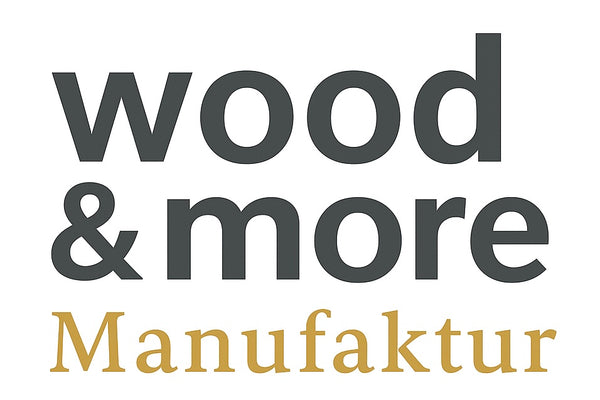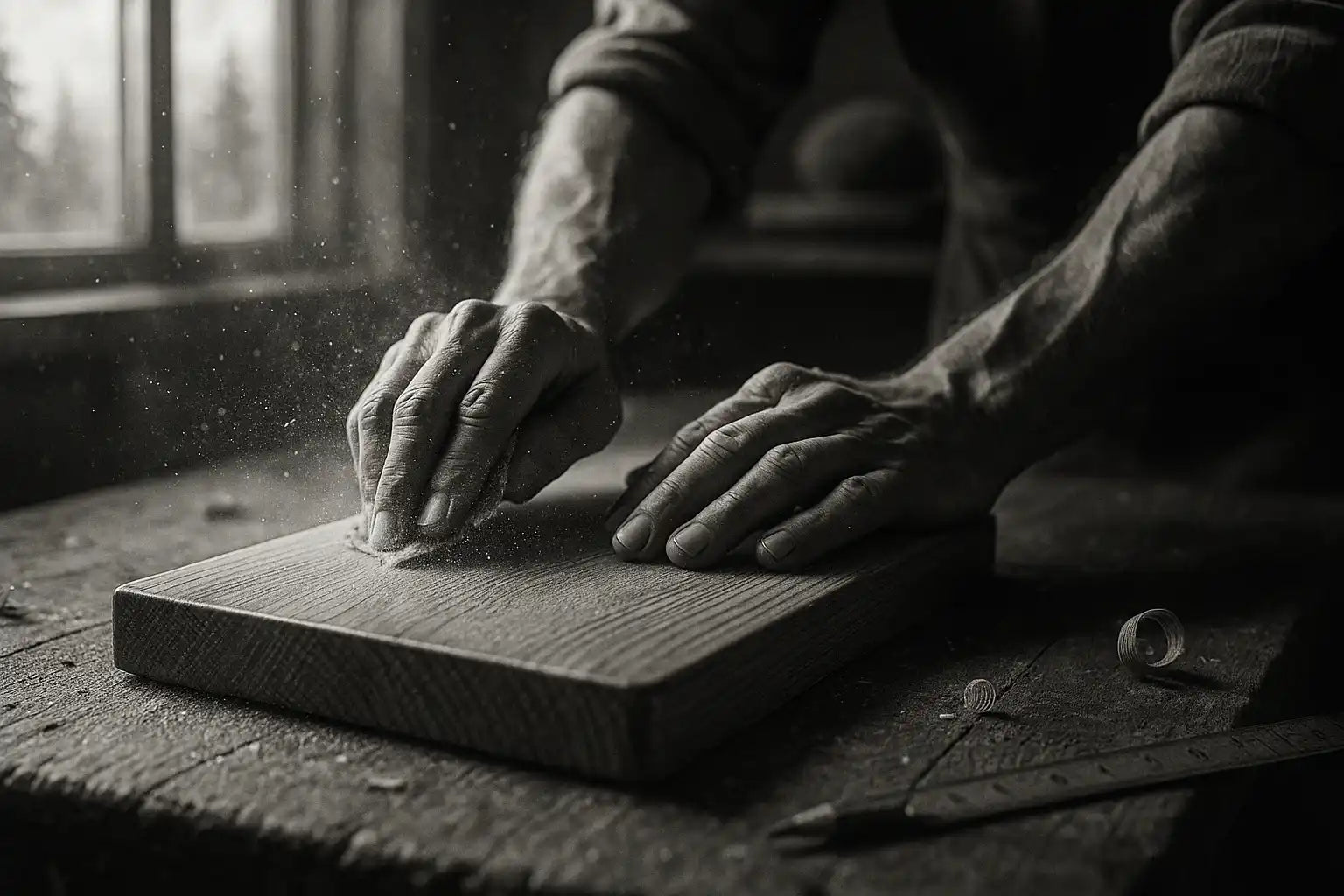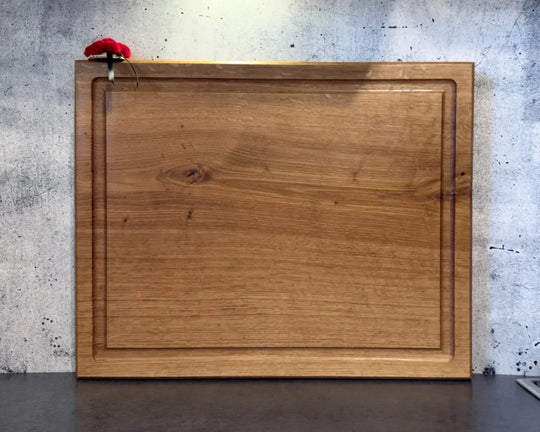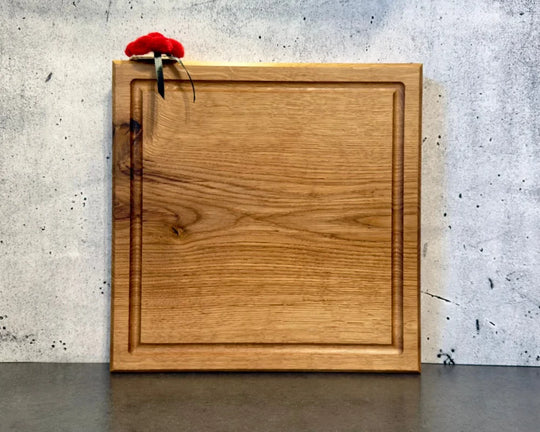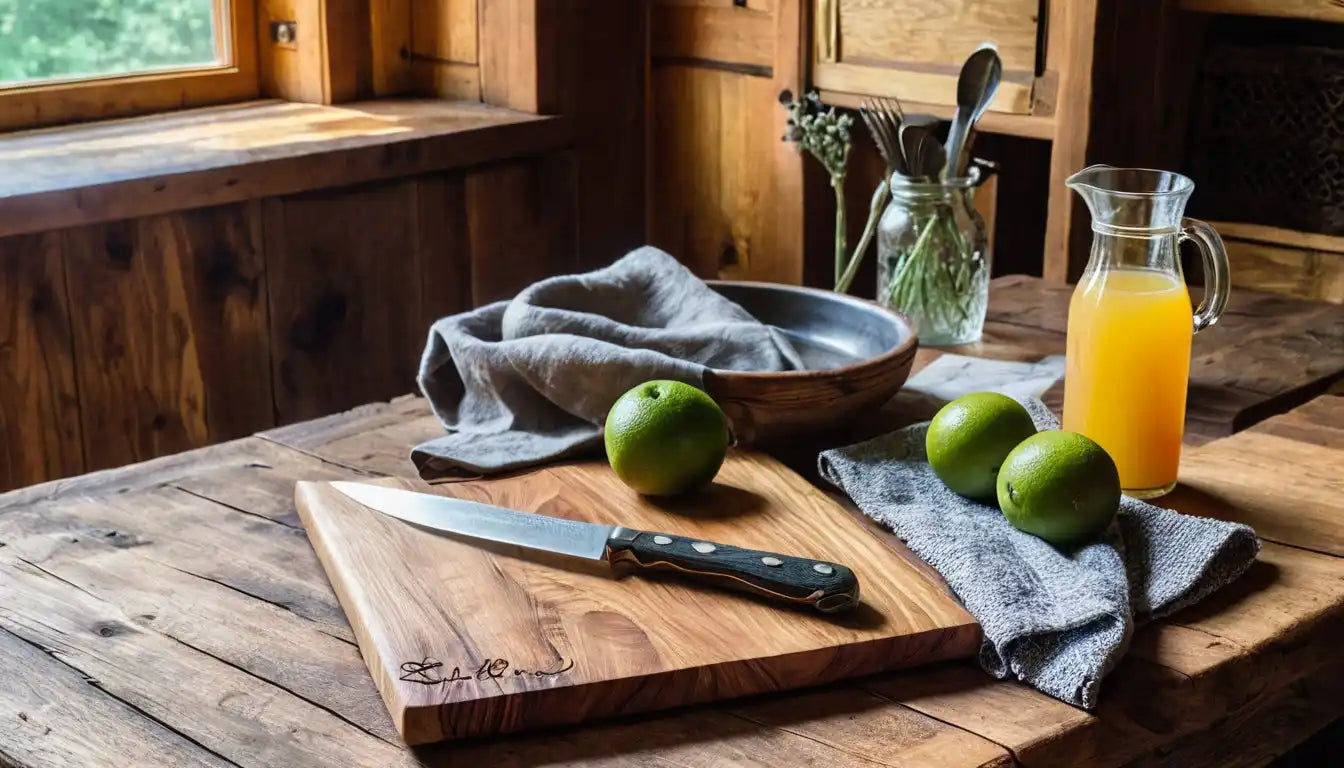Kaum ein Küchenthema ist so voller Missverständnisse wie das Schneidebrett aus Holz. „Holz ist unhygienisch“, „Das darf nicht in die Spülmaschine“, „Plastik ist doch viel robuster“ – diese Aussagen hört man oft. Doch stimmt das wirklich? In diesem Ratgeber räumen wir mit den häufigsten Irrtümern auf und zeigen, warum ein Massivholzbrett nicht nur langlebiger, sondern auch hygienischer, nachhaltiger und schöner ist, als viele denken.
1. Mythos: Auf Holz darf man kein rohes Fleisch schneiden
Dieser Irrglaube hält sich hartnäckig – dabei zeigt die Forschung seit Jahren das Gegenteil. Holz besitzt von Natur aus antibakterielle Eigenschaften. Besonders Harthölzer wie Eiche oder Nussbaum enthalten Gerbstoffe, die Keime aktiv bekämpfen. Während Bakterien auf Kunststoffoberflächen lange überleben, sterben sie im Holz meist innerhalb weniger Stunden ab.
Das Holz nimmt Feuchtigkeit kurz auf und gibt sie dann wieder ab – dabei entzieht es Bakterien den Nährboden. So entsteht ein natürlicher Selbstreinigungseffekt, den kein Kunststoff erreicht. Holz ist also keineswegs ein Risiko – sondern die sicherere Wahl.
Praxis-Tipp: Nach Gebrauch heiß abspülen, mit mildem Spülmittel reinigen und stehend trocknen lassen. Kein Spezialreiniger, keine Chemie nötig.
2. Mythos: Holz ist empfindlich und schwer zu pflegen
Holz ist kein Diva-Material, sondern erstaunlich pflegeleicht – wenn man weiß, wie. Die wichtigste Regel lautet: Nicht in die Spülmaschine. Hohe Temperaturen und aggressive Reiniger würden das natürliche Öl aus dem Holz ziehen. Aber das bedeutet nicht, dass Holz aufwendig ist – ganz im Gegenteil.
Nach jedem Gebrauch genügt heißes Wasser und etwas Spülmittel. Wer möchte, kann sein Brett alle paar Wochen mit Pflegeöl behandeln. Das Öl zieht tief ein, macht die Oberfläche wasserabweisend und betont die Maserung. So bleibt das Brett über Jahre hinweg schön und widerstandsfähig.
Pflege-Quicktipps:
• Gerüche neutralisieren: Etwas Salz aufstreuen, mit einer halben Zitrone einreiben.
• Flecken entfernen: Mit feinem Schleifvlies abreiben, anschließend nachölen.
• Pflegeintervall: Etwa einmal pro Monat ölen – bei häufiger Nutzung öfter.
3. Mythos: Holz verzieht sich oder bekommt Risse
Holz lebt – und genau das macht es so besonders. Ja, es reagiert auf Klima und Feuchtigkeit, aber das ist kein Nachteil, sondern Natur. Risse entstehen meist, wenn ein Brett falsch gelagert oder nur einseitig befeuchtet wird, etwa wenn es auf einer heißen Arbeitsfläche liegt oder in der Sonne trocknet.
Ein Massivholzbrett aus einem Stück ist von Natur aus stabiler als verleimte Bretter. Keine Leimfugen, keine Materialmischung – einfach reines Holz mit Charakter. Richtig behandelt, hält es Jahrzehnte. Und sollte sich doch einmal etwas verziehen, genügt oft leichtes Schleifen und Nachölen.
Pflege-Regel: Nie flach auf die Heizung legen, sondern stehend an der Luft trocknen. So bleibt das Brett in Form.
4. Mythos: Plastik ist robuster und hygienischer
Plastik wirkt auf den ersten Blick praktisch, ist aber in Wahrheit ein Wegwerfprodukt. Mit jedem Schnitt entstehen kleine Rillen, in denen sich Keime, Fett und Gerüche festsetzen. Selbst die Spülmaschine beseitigt diese nicht vollständig. Holz dagegen schließt kleine Schnittspuren wieder – die Fasern regenerieren sich.
Auch für deine Messer ist Holz die bessere Wahl: Die Oberfläche ist sanft zur Schneide, während Plastik sie mit der Zeit stumpf macht. Ein gutes Holzbrett hält 10 bis 20 Jahre, während ein Kunststoffbrett meist nach zwei Jahren ersetzt werden muss. Das ist nicht robuster – das ist nur kurzlebiger Konsum.
5. Alltag, Funktion & Langlebigkeit – warum Holz einfach besser funktioniert
Ein gutes Schneidebrett muss nicht nur schön sein, sondern vor allem funktionieren. Holz hat dabei einige entscheidende Vorteile: Es ist stabil, rutschfest, messerschonend – und fühlt sich beim Arbeiten einfach gut an.
-
Gewicht = Stabilität: Ein massives Brett bleibt beim Schneiden ruhig liegen.
-
Rutschfest: Gummifüße oder ein feuchtes Tuch darunter sorgen für sicheren Halt.
-
Doppelseitige Nutzung: Eine Seite für Fleisch mit Saftrille, die andere glatt für Gemüse oder Brot.
-
Saftrille: Hält Arbeitsflächen sauber und fängt Flüssigkeit auf.
Holz ist ein Werkzeug, das mit dir arbeitet – nicht gegen dich. Und es wird mit der Zeit immer besser, weil sich Oberfläche und Griffgefühl durch Nutzung verfeinern.
6. Holz in seiner schönsten Form – Stil, Charakter und Vielfalt
Holz ist nie gleich. Jedes Stück erzählt seine eigene Geschichte – durch Farbe, Maserung und Struktur. Ob du es rustikal, modern oder elegant magst, Holz bietet unendlich viele Facetten:
| Holzart |
Farbe & Struktur |
Wirkung |
Stilrichtung |
| Ahorn |
Hell, fein gemasert |
Klar & ruhig |
Modern, skandinavisch |
| Eiche |
Warm, kräftig, markant |
Charaktervoll & zeitlos |
Rustikal & klassisch |
| Esche |
Hell bis goldbeige |
Lebendig & natürlich |
Modern & vielseitig |
| Nussbaum |
Dunkel mit hellem Spiel |
Edel & tief |
Vintage & luxuriös |
Holz ist Design der Natur – kein Brett gleicht dem anderen. Ob minimalistisch, gemütlich oder markant: Dein Brett passt zu dir und bringt Wärme und Stil in deine Küche oder an den Grill.
7. Preis, Qualität & Nachhaltigkeit – was ein gutes Brett wirklich wert ist
Ein hochwertiges Holzbrett kostet mehr als ein Plastikbrett – und das hat gute Gründe. Es ist massiver, langlebiger und wird mit echter Handarbeit gefertigt. Bei wood & more entstehen alle Bretter in kleinen Serien, aus ausgesuchten europäischen Hölzern, von Hand geschliffen und geölt. Kein Massenprodukt, sondern ein echtes Stück Handwerkskunst.
Qualitätsmerkmale auf einen Blick:
• Vollholz statt verleimt
• Sauber geschliffene Oberfläche
• Lebensmittelechte Ölbehandlung
• Nachhaltige Herkunft des Holzes
• Verarbeitung in Europa
Und das Thema Nachhaltigkeit? Holz ist ein nachwachsender Rohstoff, CO₂-neutral verarbeitet, frei von Kunststoff und Chemie. Kunststoffbretter dagegen landen früher oder später auf der Deponie – und zerfallen in Mikroplastik. Mit Holz entscheidest du dich für Langlebigkeit statt Wegwerfmentalität.
Reparierbarkeit: Wenn dein Brett nach Jahren Spuren zeigt – einfach abschleifen, ölen, fertig. Kein anderes Küchenwerkzeug lässt sich so leicht auffrischen und weiterverwenden.
Entdecke Qualität, die bleibt:
→ CHEFBRETT Kollektion
→ PITMASTER BOARD
→ Pflegeprodukte & Zubehör
8. Holz & Gefühl – warum Kochen mit Holz anders ist
Wer einmal auf einem guten Holzbrett geschnitten hat, merkt den Unterschied. Das Messer gleitet leiser, das Material fühlt sich warm und lebendig an. Holz bringt Ruhe in die Küche – kein kaltes Plastik, kein synthetisches Gefühl, sondern echte Substanz.
Viele beschreiben das Arbeiten auf Holz als bewusster, entschleunigt, fast meditativ. Ein gutes Brett wird zum festen Begleiter – beim Kochen, Grillen, Servieren. Mit der Zeit entwickelt es Patina, Charakter und Geschichte. Und irgendwann sagst du nicht mehr „das Brett“, sondern einfach: mein Brett.
Fazit: Holz ist besser, als du denkst
Vielleicht dachtest du bisher, ein Holzbrett sei empfindlich, schwierig oder unpraktisch. Aber die Wahrheit ist: Es ist hygienisch, langlebig, nachhaltig und dabei wunderschön. Jedes Brett ist ein Unikat – gemacht, um Generationen zu überdauern.
Holz ist kein Trend, sondern eine Entscheidung für Qualität und Bewusstsein. Und vielleicht sagst du nach diesem Beitrag: „Oh, das wusste ich gar nicht – jetzt kommt auch für mich ein Holzbrett in Frage.“

